Arsenic Speciation in Krill and Other Marine Oils by Liquid Chromatography−Inductively Coupled Plasma-Mass Spectrometry
Special Issues
An arsenic speciation method using LA–ICP-MS was developed to provide a more accurate procedure for the determination of arsenic species in marine oils. It was validated for the analysis of five arsenic species in krill oil, and should also prove useful when quantitating inorganic arsenic species in other marine oils.
The content of total and inorganic arsenic was determined in krill oil, and the newly developed speciation method was carried out through a single laboratory validation. Krill oil samples were prepared by microwave digestion with the use of diluted nitric acid and hydrogen peroxide. Chromatographic separation of five arsenic species-arsenobetaine (AsB), dimethylarsinic acid (DMA), arsenite (AsIII), monomethylarsonic acid (MMA), and arsenate (AsV)-was achieved by high performance liquid chromatography (HPLC) using an anion exchange column and strongly basic carbonate eluent. Detection of the arsenic species was performed by inductively coupled plasma mass spectrometry (ICP-MS). Signal drift was corrected by post column addition of an internal standard. Method performance was evaluated using percent mass balance of speciated arsenic versus total arsenic, and recovery of a fortified analytical portion (FAP). The average percent mass balance from replicate preparations of krill oil samples was 95%, and the recovery of FAP of all five species met the acceptance criteria of 95–105%. This procedure should prove useful when quantitating inorganic arsenic species in marine oils.
Krill (Euphausia superba) is a small crustacean commonly found in ocean waters around the world. It mainly serves as a food source for other aquatic creatures such as fish, penguins, and whales (1). In recent years, krill has gained more popularity in the natural product industry, and the krill oil became a promising dietary supplement, due to its high content of eicosapentaenoic acid (EPA), docosahexaenoic acid (DHA), and other health promoting compounds, such as astaxanthin (2). Although similar to fish oil, the omega-3 fatty acids in krill oil are structurally different. The omega-3 fatty acids in fish oil are triglyceride bound, whereas in krill oil they are in the form of phospholipids, which can impact the way they are being absorbed by the body. (3) Although supported by limited research, the potential krill oil health benefits include improvement of heart health, reduction of inflammation and arthritic pain, decreased incidences of obesity, and cancer prevention, as well as treatment for diabetes (4–6).
Although krill oil is rich in health promoting biomolecules, marine organisms tend to accumulate elements such as arsenic from the water. Arsenic is a ubiquitous element present in the environment, and its toxicity depends not only on total concentration, but more importantly on the chemical form of the element. In general, the inorganic arsenic species (AsIII and AsV) are considered to be the most toxic, whereas other organically bound species are considered to have lower or no toxicity in humans (7,8). There are many organic forms of arsenic, including methylarsonic acid (MMA) and dimethylarsinic acid (DMA), and the more complex arsenobetaine (AsB). Even though methylated arsenic species have been known to be less toxic than the inorganic species, to conduct a proper risk assessment all arsenic species present in the evaluated material should be identified. Although extensive literature has been published on the topic (9–11), arsenic speciation remains a challenging task, and requires thorough understanding of the species present in the analyzed matrix (12).
In recent years, the global demand for krill oil has been on the rise. The increasing popularity of this dietary ingredient has led to increased scrutiny by standard- setting bodies and government regulations around the world. In December 2017, the Food Chemicals Codex (FCC), a collection of internationally recognized standards for the purity and identity of food ingredients, released a monographed standard for krill oil. The aim of the monograph was to help promote quality krill oil identification and purity testing to strengthen the position of krill in the marketplace (13). Included in the requirements for krill oil are standards for EPA, DHA, phospholipids, and astaxanthin. The monograph also included a limit for inorganic arsenic at NMT 0.1 mg/kg (14). The method defined in the monograph, which is not able to accurately differentiate between the chemical species of arsenic, cannot be compared with higher sensitivity and specificity speciation methods, such as HPLC-ICP-MS. Additionally, the complexity of the krill oil matrix requires suitable sample preparation able to liberate arsenic species, and allow for precise quantitation of inorganic arsenic. The aim of this study was to develop and validate a method for arsenic speciation and determination of inorganic arsenic in krill oil samples, and thus contribute to a more accurate risk assessment analysis regarding consumption of krill oil supplements.
Experimental
Samples
Samples of krill oil dietary supplements were purchased and found to be representative of the various krill oil suppliers present in the marketplace today.
Reagents
All reagents and solutions were prepared using ultrapure water purchased from EMD Millipore. Trace metal grade hydrochloric acid (HCl), nitric acid (HNO3) and hydrogen peroxide (H2O2, 30%) were sourced from VWR Chemicals BDH. Ammonium carbonate (CH8N2O3) was sourced from Alfa Aesar. Sodium hydroxide (50% in water), 200 proof ethanol, ethylenediaminetetraacetic acid disodium salt dehydrate (EDTA), and Triton X-100 were purchased from MilliporeSigma. Ultrahigh purity argon and helium were supplied by Airgas.
Determination of Total Arsenic by ICP-MS
The content of total arsenic in the krill oil was determined by ICP-MS. Briefly, samples of approximately 250 mg of homogenized krill oil were digested with 5 mL of HNO3 and 0.5 mL of HCl in PTFE high pressure vessels using a microwave (Mars 6, CEM Corporation). After completion of the cycle, samples were cooled to room temperature, transferred into DigiTubes (SCP Science), and diluted to 50 mL with ultrapure water. Following additional 5x dilution with 2% HNO3:0.5%HCl:0.01% Triton X-100, the total arsenic content in krill oil was determined using an Agilent 7700 ICP-MS instrument (Agilent Technologies). The instrument conditions are outlined in Table I. For total arsenic determination, a multielemental standard was used (SPEX Certiprep), and prepared in 2% HNO3:0.5%HCl:0.01% Triton X-100 solution at concentrations ranging from 0 to 200 ng/g.
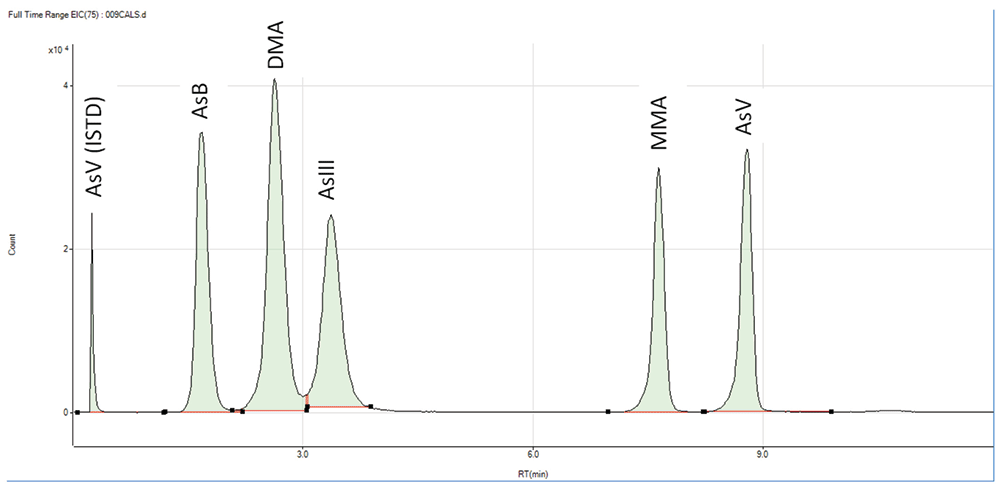
Figure 1: Chromatographic separation of five arsenic species in a standard solution.
Determination of Inorganic Arsenic by HPLC-ICP-MS
For the determination of inorganic arsenic, approximately 250 mg of sample was weighed directly into a PTFE digestion vessel. Using a calibrated volumetric spigot, 5 mL of 0.28M HNO3 was added to each sample, followed by 2.5 mL of hydrogen peroxide. Samples were digested using a progressive microwave program (Mars 6, CEM Corporation). The progressive power ramp from 290–1800 W was executed over 25 min, after which the samples were held for additional 25 min while heated at 210 °C. The use of microwave and hydrogen peroxide in preparation of krill oil sample resulted in a cleaner digestate and more efficient extraction of arsenic from the matrix. Additionally, the quantitative oxidation of AsIII to AsV allowed the determination of total inorganic arsenic as a sum of AsIII and AsV. It has been previously verified that no conversion of organic species to inorganic arsenic occurs (15). Prior to analysis, the samples were transferred into a single use calibrated polypropylene DigiTubes (SCP Science), and diluted to 50 mL with 2.5 mM ammonium carbonate:0.2 mM EDTA:1% ethanol pH 11.0. Samples were filtered through PTFE syringe filters into polypropylene HPLC vials, capped, and submitted for HPLC-ICP-MS analysis.
Five standards were used for the speciation analysis: arsenite (AsIII) and arsenate (AsV) (1000 mg/L, Spex Certiprep), dimethylarsinic acid (DMA) (Alfa Aesar), monomethylarsonic acid (MMA) (ChemService, Inc.), and arsenobetaine (AsB) (Honeywell Fluka Chemicals) (Figure 1).

Figure 2: Chromatographic separation of detected arsenic species in krill oil.
All stock solutions were prepared at 1000 µg/g, and their concentrations were based on elemental arsenic, rather than the molecular weight of the arseno compounds. All arsenic stock standards, except for As III and As V, which are traceable to NIST SRM, needed to be analyzed for total arsenic content to confirm the stock concentration. An intermediate solution was prepared at 200 ng/g, and used in preparation of working standards at concentrations ranging from 0.25–20 ng/g. Working arsenic standards were prepared in a solution of 2.5 mM ammonium carbonate:0.2 mM EDTA:1% ethanol pH 11.0. The analysis was performed using an Agilent 1260 HPLC system (Agilent Technologies), consisting of a quaternary pump, autosampler, and a column compartment equipped with a six port switching valve. The chromatographic separation was achieved on an Agilent anion exchange speciation column (Agilent Technologies) (Figure 2).
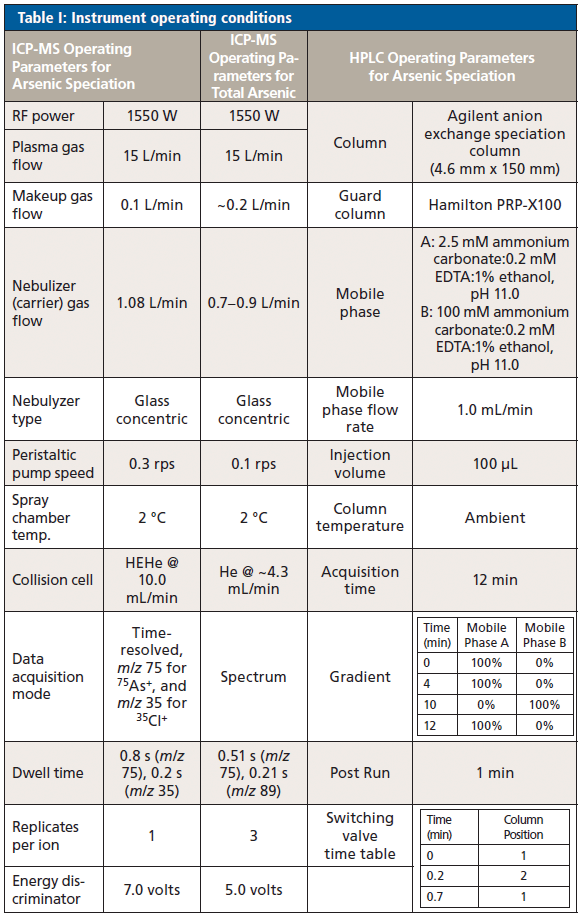
An isocratic pump (Agilent Technologies) was used as an auxiliary pump for the introduction of an internal standard during the analysis. The internal standard (50 ng/g AsV in mobile phase A) was delivered to the switching valve using the isocratic pump post column through programmed column switching, using a 50 µL injection loop, which allows for signal drift monitoring and peak response correction. The speciated arsenic was determined with the use of Agilent 7700 ICP-MS (Agilent Technologies). The ICP-MS and HPLC conditions are shown in Table I.
Results and Discussion
Method Validation and Quality Control
The method was carried out through a single laboratory validation according to the ICH Analytical Method Validation Guidelines (16), following criteria for arsenic speciation described in Elemental Analysis Manual (EAM) 4.11 (17). Evaluated parameters included linearity, repeatability, intermediate precision, specificity, system suitability, limit of detection (LOD), and limit of quantitation (LOQ). In addition, the accuracy of a fortified analytical portion (FAP) was determined. As a part of quality control procedures, the percent mass balance was calculated between the sum of all arsenic species detected and the total arsenic determined in each sample.
An analytical solution detection limit (ASDL) and analytical solution quantitation limit (ASQL) was established for each analyzed arsenic species following the FDA's EAM, section 3.2 (18), and were based on standard deviation of replicate analyses of a low level mixed standard. The method limit of detection (LOD) and limit of quantitation (LOQ) were calculated using the ASDL and ASQL multiplied by the dilution factor. A summary of the method's detection and quantitation limits are summarized in Table II.
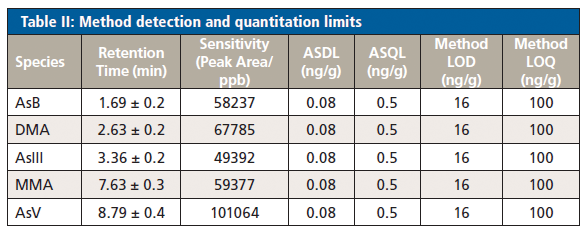
Calibration curves consisting of five points were established for all analyzed arsenic species, and were linear over the entire concentration range with R2 > 0.999. Precision of replicate preparations of the krill oil sample (n = 3) was performed. The RSD limit for detected arsenic species in replicate preparations was set at <10%. The results from replicate preparations of the krill oil sample are summarized in Table III.
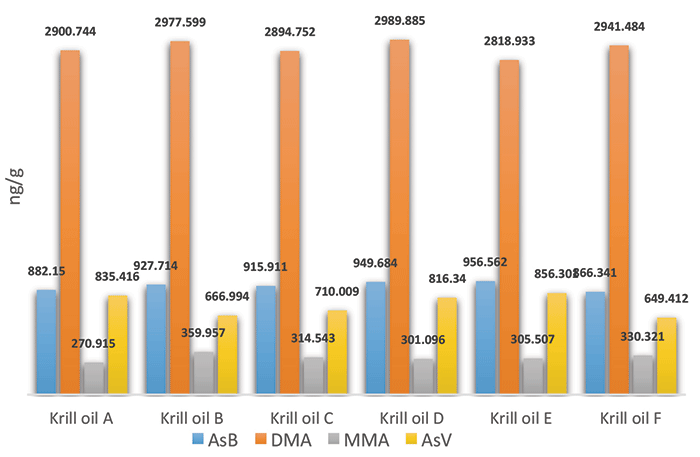
Figure 3: Reproducibility data of arsenic species determined in replicate preparations of krill oil.
Intermediate precision data was obtained to demonstrate the method's performance over time. The RSD limit of all replicates (n = 6) was set at <15%, and met the criteria. Reproducibility data of arsenic species determined in replicate preparations of krill oil is shown in Figure 3.
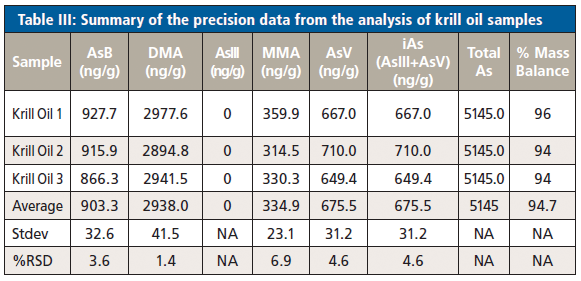
The fortification (spike) recovery and precision was established for each of the arsenic species determined in the krill oil (n = 3). The sample was spiked with a mixed standard at 50% of the concentration determined for each arsenic species. The determination of FAP recoveries was performed through standard addition, and the mean recoveries of spiked arsenic was within 94–105% for AsB, DMA, and MMA. Inorganic arsenic was determined as a sum of AsIII and AsV, and the recovery for total iAs was within 98–102%.
Mass balance was calculated between the sum of all arsenic species detected and the total arsenic determined in the krill oil sample. The percent mass balance was determined for each sample analyzed, and serves as a quality control measure to ensure that most of the arsenic is accounted for in the speciation analysis.
Due to lack of a certified reference material (CRM) for arsenic speciation in matrix similar to krill oil, trueness of the method performance could not be verified.
A large body of published literature reports arsenobetaine as the predominant organic arsenic form present in marine organisms (19–21); nonetheless, the most abundant arsenic species identified in krill oil samples appeared to be DMA. It was observed previously that the microwave digestion of samples in the presence of H2O2 oxidizes AsIII to the more stable AsV; however, a conversion of AsB to DMA has not been reported. To determine the native arsenic species present in krill oil, an alternate sample preparation was adapted to preserve the arsenic species.
Krill oil samples were prepared as described in EAM 4.11, and digested without the use of hydrogen peroxide in a heating block. Although the recovery of arsenic from the krill oil sample following another preparation was poor, the chromatographic separation of arsenic species confirmed the predominance of AsB. The mechanism of conversion of AsB to DMA under oxidative conditions is not clear; nevertheless, arsenobetaine degradation by microorganisms has been previously described by Hanoka and associates (1989) (22). Although the AsB to DMA conversion does not affect the iAs result or the determination of percent mass balance, it is worth mentioning that it changes the expected arsenic profile in material of marine origin.
Conclusion
An arsenic speciation method was developed and validated to provide a more accurate procedure for the determination of arsenic species in marine oils. The results obtained from this study demonstrated the method's applicability for determination of arsenic species in krill oil; however, it should be noted that the level of iAs detected in the analyzed krill oil exceeded the limit set by the FCC. The specificity of our method allows for more accurate iAs determination in such matrices compared to other published methods, and highlights the importance of using methods fit for purpose when establishing regulatory limits.
References
(1) J.M. Kwantes and O. Grundmann, J. Diet. Suppl.12(1), 23–35 (2015). doi: 10.3109/19390211.2014.902000
(2) J.C. Tou, J. Jaczynski, and Y.C. Chen, Nutr. Rev., 65(2), 63–77 (2007). doi.org/10.1111/j.1753-4887.2007.tb00283.x
(3) S. Ulven and K.B. Holven, Vasc. Health Risk Manag. 11, 511–524 (2015). doi:10.2147/VHRM.S85165
(4) K. Yurko-Maur, J. Kralovec, E. Bailey-Hall, V. Smeberg, J. G. Star, and N. Salem, Lipids Health Dis. 14, 99 (2015).
(5) N.F. Vigerust, B. Bjørndal, P. Bohov, and T. Brattelid, TNF-α. Eur J Nutr 52, 1315 (2013).
(6) L. Deutsch, J. Am. Coll. Nutr. 26(1), 39–48 (2007). doi:10.1080/07315724.2007.10719584
(7) K. Cheyns, H. Demaegdt, N. Waegeneers, A. Ruttens, "Arsenic Speciation Analysis Elucidates the Risk Assesment of Food Supplements with Ingredients of Marine Origin." 9th Nordic Conference on Plasma Spectrochemistry, Sciensano (2017)
(8) V. Sele, J.J. Sloth, A.K. Lundebye, E.H. Larsen, M.H.G. Berntssen, and H. Amlund, Food Chem. 133, 618–630 (2012).
(9) J.J. Sloth, Abstract for the presentation at the EU-RL-ISS Workshop, October 7-8, 2013.
(10) A.A. Ammann, Am. J. Anal. Chem. 2, 27–45 (2011).
(11) Z. Gong, X. Lu, M. Ma, C. Watt, and X.C. Le, Talanta 58, 77–96 (2002).
(12) National Research Council (US) Subcommittee on Arsenic in Drinking Water. Arsenic in Drinking Water (National Academies Press, Washington, D.C., 1999), pp. 27–82.
(13) S. Daniels, Supplier, (2013) https://www.nutraingredients-usa.com/Article/2013/12/11/USP-monograph-strengthens-krill-s-position-in-the-marketplace-Suppliers
(14) 2018 USPC-Krill Oil-FCC Forum, December 2017
(15) E. H. Larsen, I. Rokkjaer, and T. Christensen, in The Determination of Chemical Elements in Food: Applications for Atomic and Mass Spectrometry, S. Caroli, Ed. (John Wiley & Sons, Hoboken, New Jersey, 2007), pp. 297–332.
(16) International Conference on Harmonisation of Technical Requirements for Registration of Pharmaceuticals for Human Use, ICH Harmonised Tripartite Guideline, Validation of Analytical Procedures: Text and Methodology Q2 (R1), Incorporated in November 2005.
(17) K. M. Kubachka, N. V. Shockey, T. A. Hanley, S. D. Conklin, and D. T. Heitkemper, Arsenic Speciation in Rice and Rice Products Using High Performance Liquid Chromatography- Inductively Coupled Plasma-Mass Spectrometric Determination:FDA U.S. Food and Drug Administration Elemental Analysis Manual for Food and Related Products (Food and Drug Administration, Silver Spring, Maryland, 2012)
(18) W. C. Cunningham, W. R. Mindak, S. G. Capar, Elemental Analysis Manual (Section 3.2 Terminology) (Food and Drug Administration, Silver Spring, Maryland, 2014)
(19) R. V. Hedegaard and J. J. Sloth, Biothechnol. Agron. Soc. Environ. 15(S1), 45–51 (2011)
(20) R.V. Hedegaard, I. Rokkjaer, and J.J. Sloth, Anal. Bioanal. Chem. 405(13), 4429–4435 (2013)
(21) P. Piras, R. Orletti, G. Chessa, C. Carloni, F. Griffoni, P. Palombo, and F. Velieri, Ital. J. Food Saf. 4(1), 4577 (2015)
(22) K. Hanoka, K. Kazuhiko Ueno, S. Tagawa, and T. Kaise, Comp. Biochem. 94(2), 379–382 (1989).
Katarzyna Banaszewski, Anna Plocicka-Okladlo, and Aaron Secrist are with NOW Foods, in Bloomingdale, Illinois. Direct correspondence to: k.banaszewski@nowfoods.com
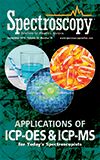
Trending on Spectroscopy: The Top Content of 2024
December 30th 2024In 2024, we launched multiple content series, covered major conferences, presented two awards, and continued our monthly Analytically Speaking episodes. Below, you'll find a selection of the most popular content from Spectroscopy over the past year.
The Fundamental Role of Advanced Hyphenated Techniques in Lithium-Ion Battery Research
December 4th 2024Spectroscopy spoke with Uwe Karst, a full professor at the University of Münster in the Institute of Inorganic and Analytical Chemistry, to discuss his research on hyphenated analytical techniques in battery research.